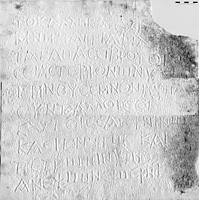 MAMA XI 303 (Konya)
MAMA XI 303 (Konya) 
Verse funerary inscription of Asterios and others
- Type of monument:
- Funerary inscription in verse.
- Location:
- Karakaya (Konya): in a stable.
- Description:
- Grey marble column, broken below, buried above. Above the inscription, Latin cross in relief.
- Dimensions:
- Ht. 0.90+; Diameter 0.33; letters 0.020-0.030.
- Record:
- Squeeze; line-drawing; MB notebook copy (1957/40).
- Publication:
- None.
- Date:
- Fourth or fifth century AD.
τὸ κάλλη κατέχι
μνῆμα τρία φίλ-
τατα πᾶσει βροτοῖ-
σει, Ἀστέριον πινυ-
5τὴν Θ(εο)ῦ σεμνὸν ἱερῆα
σύν τ᾿ ἄλλοισει
κλυτοῖς Σατορνίνῳ
κασιγνήτῳ καὶ
Πέτρῳ πινυτῇ
10ἀνεψιῷ νέῳ ἔρνι.
The beautiful tomb holds three who were most dear to all mortals, Asterios, the prudent and noble priest of God, with two other glorious men, Saturninus his brother and Petros his prudent cousin, the new shoot.




Karakaya is a small village at the eastern edge of the Konya plain, at the foot of the Boz Dağ between Divanlar and Göçü. This Christian funerary inscription appears to be an attempt at a pair of elegiac couplets. The name Asterios seems to have been particularly popular among Christians: cf. MAMA I 200, 240 (Laodikeia Katakekaumene), MAMA VII 109b (Lageina), TAM V 1, 643 (Daldis), IAph2007 1.19. For the term πινυτός (lines 4-5) as used of priests, cf. I.Konya 206 (Yağlıbayat: Savatra), ἱερεὺς... πιστὸς κὲ πινυτός, and see also MAMA XI 207 (1954/43: Çeşmelisebil). For the term σεμνός (rare for men), cf. MAMA XI 284 (1956/129: Zengicek/Koçyaka); 307 (1956/159a: Koçaş). For the phrase νέον ἔρνος (line 10), see the commentary to MAMA XI 361 (1954/51: Kana).